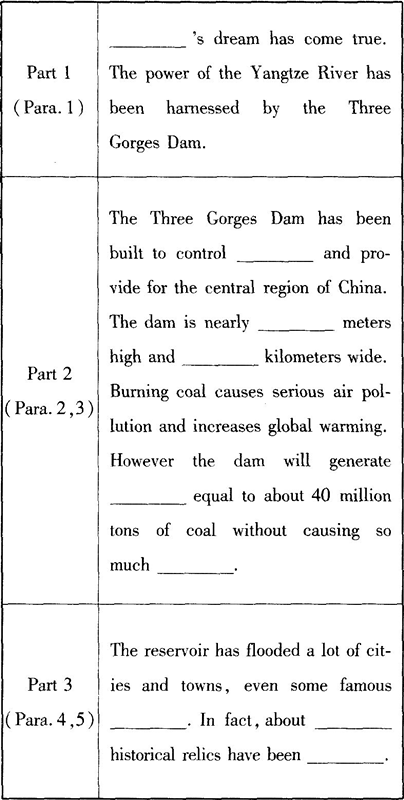二、 简答题(本大题共1小题,共20分)
根据题目要求完成下列任务,用中文作答。
31. 简述思维导图(mind mapping)的含义(4分)及其两个用途(6分),写出教师在课堂教学中运用思维导图的三点注意事项(6分),并举一例说明思维导图的用法。(4分)
(1)思维导图是一种使用图形来组织和表达发散性思维的工具。它运用图文并重的技巧,把各级主题的关系用相互隶属与相关的层级图表现出来,建立主题关键词与图像、颜色等要素之间的记忆链接。
(2)思维导图的两个用途:学生在学习中可以利用思维导图组织学习内容、整理知识框架等,以提升学习效率。例如,在预习时,学生可以利用思维导图展现新旧知识间的联系,促进知识的有效迁移;在课堂上,学生可以利用思维导图做课堂笔记,节省时间,方便记忆;在复习时,学生可以利用思维导图有效整合知识,加强记忆。
教师在教学中可以利用思维导图制作教学计划、整理教学设计、展示教学内容等,以提升教学效率。例如,在语法课上,教师可以利用思维导图构建语法知识网络;在阅读课上,教师可以利用思维导图展示文章组织结构;在写作课上,教师可以利用思维导图理清写作思路。
(3)教师在课堂教学中运用思维导图的三点注意事项:
①要注意相关性。思维导图所归纳、总结的知识都应围绕某个主题来展开。教师要为学生创设与学习主题相关的、学生感兴趣的问题情境,激发学生的学习兴趣,调动其学习积极性,然后指导学生以问题情境为中心构建思维导图。
②要注意灵活性。思维可视化的形式应依据不同问题的性质而自由变化,不必拘泥于固定的思路和风格。
③要注意适度性。思维导图只是一种辅助教学的工具,教师不能完全依赖它。
(4)案例:在阅读篇幅长、生词多、文章结构和层次复杂或不太清晰的文章时,先由教师呈现思维导图,大概地介绍全文大意,帮助学生整体理解文章;然后,根据中心主题和主干提出问题,学生带着问题分部分、分层次阅读,突出重点,关注细节,加深理解;阅读后,可让学生在小组内进行分享和交流,此时教师在多媒体课件中利用思维导图呈现答案的关键词,帮助学生梳理知识点;最后,教师引导学生根据思维导图的提示复述课文内容。
三、教学情境分析题
32.下面片段选自某高中英语课堂教学实录。
T.. Good morning, boys and girls. We talked about some verbs yesterday. Now I'd like to see whether you have learned to use them. Are you ready?
Ss : Yes.
T:Listen! Yesterday, you were going to play football after school when it began to rain, so you tidn't do it. Can you describe it with the word "prevent"? Who would like to have a try?
S1 :We didn't play football yesterday because a sudden rain prevented us.
T:OK. But would you please begin your sentence with "The sudden rain..."? Who'd like to try?
S2: The sudden rain prevented us to play football yesterday.
T: Oh, you are so quick, and you are almost right.Do we say " prevent somebody to do something" or "prevent somebody... "
S3 : Oh. The sudden rain prevented us from playing football yesterday.
T: Prefect. Let's read S3's sentence together and remember the verb pattern of“prevent”, OK?
根据该教学片段回答下面四个问题:
(1)该教师采取了什么方式引出复习巩固的内容?(5分)
(2)当该教师发现学生没有完全掌握所学内容时,采取了什么补救方法?(5分)
(3)这种补救方法有哪两个优点?(10分)
(4)该教师复习巩固所教内容还可以采用其他哪两种方法?(10分)
(1)该教师采用了提问的方式引出复习巩固的内容。为了检测学生是否掌握所学动词“prevent”的用法。该教师创设了相关情境,逐步引导学生回答问题,达到使学生巩固单词、学以致用的目的。
(2)该教师用的补救方法为提示法。该教师的初衷是让学生能够正确运用“prevent sb.from doing sth.”结构,当学生未能使用此用法时,该教师用句子的开头部分“The sudden rain…”来提示学生说出完整的句子以达到巩固该动词用法的效果。
(3)这种补救方法的两个优点:
①具有启发性,能促进学生积极思考。在词汇巩固教学中,教师通过提示部分相关信息启发学生回忆所学单词的相关用法,让学生主动建构知识,使之印象更深,并且有利于培养学生的自主学习意识。
②具有针对性,能节省时间,突出重点。“prevent sb.from doing sth.”是“prevent”的重要用法。该教师带领学生巩固此用法,重点突出,针对性强,注重实效,做到了有的放矢。
(4)复习巩固所教内容还可以采用的其他两种方法:
①测试法。教师可以将带有“prevent”的句子改编成填空题或选择题对学生进行测试,测试结束后可带领学生朗读完整的句子,巩固“prevent sb.from doing sth.”的用法。此方法可以加深学生对该词的记忆和理解。
②对比法。教师可以让学生进行头脑风暴,想出与“prevent”相关的词组及例句,如“avmd doing sth.”“prevent sb.from doing sth.”等,并对比区分不同动词的用法。该方法能够激发学生的思考、活跃学生的思维,让学生对知识点进行系统学习,达到巩固知识的目的。
四、教学设计题(本大题1小题,40分)
根据提供的信息和语言素材设计教学方案,用英文作答。
33.
设计任务:请阅读下面学生信息和语言素材,设计20分钟英语阅读的教学方案。
教案没有固定格式,但须包含下列要点:
·teaching objectives
· teaching contents
·key and difficult points
·major steps and time allocation
·aetivities and justifications
教学时间:20分钟
学生概况:某城镇普通中学高中一年级学生,班级人数40人。多数学生已经达到《普通高中英语课程标准(实验)》五级水平。学生课堂参与积极性一般。
语言素材:
The Three Gorges Dam
"Walls of stone to hold back clouds and rain"
Mao Zedong wrote a poem in which he dreamed of "walls of stone to hold back clouds and rain till a smooth lake rises in the narrow gorges". Now his dream has come true. The power of the Yangtze River,which is the world" third longest river, has been harnessed by the Three Gorges Dam.
The Three Gorges Dam, which is the biggest construction project in China since the building of the Great Wall and the Grand Canal, has been built to control flooding and provide hydro-electric power for the central region of China. The dam is nearly 200 meters high and 1.5 kilometers wide. It is the largest hydro-electric power station and dam in the world and has cost more than any other construction project in history.
Sun Yat-sen ,who was the leader of the 1911 Revolution, first suggested the idea of a dam across the Yangtze River in 1919. Three quarters of China's energy is produced by burning coal. In 1993, China used 1.2 billion tons of coal for heating and generating electricity. Unfortunately, burning coal causes se-rious air pollution and increases global warming. The dam will generate electricity equal to about 40 mil-lion tons of coat without causing so much air pollution.
The reservoir has flooded 2 cities,11 counties,140 towns and more than 4,000 villages. More than a million people who lived in the region have moved from their homes. Now they're living in a happy new life in different areas.
The Three Gorges area is one of the most beautiful areas of China and the project has flooded some of China's most famous historical sites, including the Qu Yuan Temple, the Han Watchtower and the Moya Cliff carvings. About 800 historical relics have been submerged. Some of them are being removed and are being put into museums.
【参考设计】
Teaching Contents :
The lesson mainly talks about the Three Gorges Dam, including its features, advantages and disad-vantages.
Teaching Objectives :
( 1 ) Knowledge objective
Students can get more information about the fea-tures, advantages and disadvantages of the Three Gorges Dam.
(2) Ability objectives
① Studentscanimprovetheirreadingabilities through fast reading and detailed reading.
②Students can introduce the Three Gorges Dam in their own words.
( 3 ) Emotional objective
Students can develop a sense of national pride through learuing this passage.
Teaching Key and Difficult Points:
Students can get a general idea of the passage and learn to use reading strategies to understand the material.
Major Steps :
Step 1 Warming up (3 minutes)
Show a poem of Mao Zedong on PPT:Walls of stone to hold back clouds and rain till a smooth lake rises in the narrow gorges. Ask students which place it is.
Then show some
beautiful pictures of the Three Gorges Dam.Tell students today we will have a visit here.
(Justification:The poemand pictures can arouse students’interest in this class. )
Step 2 Pre-reading(4 minutes)
Ask students to have a
discussion:Why did we Chi-nese build the Three Gorges Dam? Then ask some of
them to share their ideas.
(Justification: Through discussion, students will be prepared for the reading class, and it will be helpful to understand the material. )
Step 3 While-reading (8 minutes)
Task 1
Ask students to read the passage quickly and give a summary of each paragraph. Ask some students to share their ideas and help students to analyze the ar-ticle structure.
Task 2
Ask students to read the passage again and complete the following table. Then ask some students to show their answers and give assessments.

Task 3
Ask students to pay attention to Paragraph 2-5, anddiscuss the questions below with partners:
( 1 ) What's the biggest advantage of the Three Gor-ges Dam project?
(2) What has happened to the historical relics near the Three Gorges Dam7
( 3 ) What do you think about the Three Gorges Dam?
Ask some groups to show their opinions and lead studentstolearnthenecessityoftheThree Gorges Dam.
(Justification: Through three tasks, students can have a thorough understanding of the passage, and learn the reading strategies. )
Step 4 Post-reading (5 minutes)
Role play:Divide students into groups of four. Three students act as engineers from the Three Gorges Dam and one student as a reporter. The reporter asks some questions about the Three Gorges Dam and their feelings about the construction project. After three minutes, invite some groups to show their dialogues.
(Justification: Students can talk about the Three Gorges in their own words and develop a sense of na-tional pride. )
面试辅导:教师资格证面试如何快速通关?233网校讲师将面试情景还原,助你一举攻下“结构化面试+试讲+答辩”三大内容,实战通关!免费体验>>

